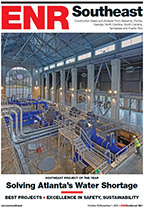The first two projects to be built under the Utah Science Technology and Research initiative are under construction, with one project slated for completion in the fall and the other about halfway done.
The $50-million USTAR Life Sciences Research Center at Utah State University in Logan is being built by Gramoll Construction of North Salt Lake and is a month ahead of schedule and on budget, says project manager Gary Hansen. It will be completed in October.
The other USTAR project is the $130-million James L. Sorenson Molecular Biotechnology Building at the University of Utah in Salt Lake City. Sandy, Utah-based Layton Construction is the general contractor.
Project manager Jake Greenland says the project is finally back on schedule after various delays, and construction should complete in November 2011.
“We think both of these facilities will turn into magnets for collaboration with researchers and industry in developing new business and new jobs for the state of Utah,” says Michael O’Malley, marketing and communications director for USTAR.
“A lot of thought has gone into the design of these buildings and the interdisciplinary support. We think that the payoff will be adding to the assets to the state of Utah to tackle some of the big problems humanity faces.”
USTAR is important not only to the universities but also to the state, says Rich Thorn, president/CEO of the Associated General Contractors of Utah.
The USTAR initiative was originally passed by the Utah Legislature in March 2006 under Senate Bill 75, which helps ensure that higher-education facilities in the Beehive State receive proper funding for investments that will help attract world-class researchers to new interdisciplinary research and development facilities.
USTAR seeks to generate more technology-based start-up firms, higher paying jobs and additional business activity, leading to a statewide expansion of Utah’s tax base.
USTAR is divided into three program areas—Research Teams, Research Building Projects and Technology Outreach. They focus on energy, biomedical technology, brain medicine, nanotechnology, imaging technology and digital media.
USTAR Life Sciences Research Center
Crews are a month ahead of schedule on the 111,000-sq-ft Life Sciences Research facility. Hansen says the three-story building with mechanical penthouse is a steel-frame, cross-brace structure with 7.5-in.-thick, cast-in-place concrete floors that help ensure vibration control, a critical component of high-tech laboratory research.
A special non-shrink additive was used in the concrete mix design to eliminate any cracking or pinholes in the finish. The building includes 930,000 lb of rebar, 1.4 million lb of steel and 103,000 lb of brace frames.
The foundation is a matte footing that required approximately 3,600 cu yd of concrete poured over the space of three days. Foundation walls are 30 in. thick. The project is aiming for LEED-Gold certification.
“We’ve been doing a lot of laboratory projects for universities in the state, so the USTAR project at Utah State was a natural fit for us,” says Jim Gramoll, president of Gramoll Construction.
Hansen adds: “The sheer complexity of the building has been challenging at times. We really had to beef up the structure with rebar and concrete. The fact that we’re a month ahead of schedule says a lot about the subs working on this project.”
Jeff Nielson, project manager for Salt Lake-based ajc architects, the project architect, says the building is “going to be a real standout in modern vivarium design.”
James L. Sorenson Molecular Biotechnology Building
Located at the site of the former University of Utah golf course, the 140,000-sq-ft biotech building has required a tremendous amount of site and utility work, including the installation of more than a mile of sewer line and a 2,800-ft-long, cast-in-place concrete tunnel that is a major part of the building’s infrastructure, says project manager Greenland.







Post a comment to this article
Report Abusive Comment